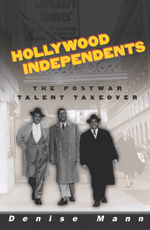(University of Minnesota Press, 344 pages, $25)
By Denise Mann
 When we talk about “Independent Hollywood” today, we tend to think of the Sundance generation of the mid-1990s, and forget that independent filmmaking in Hollywood—meaning movies in which creative talent has a controlling stake—enjoys a pedigree stretching back to United Artists in the 1920s. But the term also describes a seminal moment in Hollywood history—the emergence of talent-turned-producer after World War II. This was spurred by the U.S. Justice Department’s 1948 antitrust suit against the studios’ production-distribution-exhibition monopoly. That development, along with falling revenues, the rise of TV and the super-agency MCA, saw the studios divesting themselves of hundreds of formerly indentured players and in-house directors. The smart ones founded their own production companies and many—Stewart, Lancaster, Cagney, Douglas, Kazan, Wilder, Hitchcock, Huston, Preminger and Mankiewicz, among others—flourished and got rich, or richer, as independents.
When we talk about “Independent Hollywood” today, we tend to think of the Sundance generation of the mid-1990s, and forget that independent filmmaking in Hollywood—meaning movies in which creative talent has a controlling stake—enjoys a pedigree stretching back to United Artists in the 1920s. But the term also describes a seminal moment in Hollywood history—the emergence of talent-turned-producer after World War II. This was spurred by the U.S. Justice Department’s 1948 antitrust suit against the studios’ production-distribution-exhibition monopoly. That development, along with falling revenues, the rise of TV and the super-agency MCA, saw the studios divesting themselves of hundreds of formerly indentured players and in-house directors. The smart ones founded their own production companies and many—Stewart, Lancaster, Cagney, Douglas, Kazan, Wilder, Hitchcock, Huston, Preminger and Mankiewicz, among others—flourished and got rich, or richer, as independents.
Denise Mann’s meticulously researched critical history digs deeply into the long prelude to this sea change. It was generally deemed to have begun after Stewart’s company won profit-participation on Winchester ’73 in 1950. Eventually, the rise of independents transformed Hollywood, both financially and artistically, planting a long fuse that would detonate spectacularly in the Hollywood Renaissance of the early ’70s. Mann examines the list of great American movies made in spite of, rather than thanks to, the studios, and it is a long and impressive one. It includes landmark liberal movies by the greatest filmmakers of the period: Kiss Me Deadly, On the Waterfront, A Face in the Crowd, Touch of Evil, Invasion of the Bodysnatchers, Sweet Smell of Success and The Manchurian Candidate.
Mann deftly sorts out a complicated political and artistic saga, first concentrating broadly on the business side and the postwar political environment in Hollywood. She then analyzes emblematic indies to trace how the films reflect the often free-thinking and sometimes openly dissident circumstances in which they were conceived and created. While Mann’s academic style may prove a bit of a challenge at times for the general reader, she never falls into jargonese, and offers one of the best available accounts of this transformative period in modern moviemaking.
Review written by John Patterson.